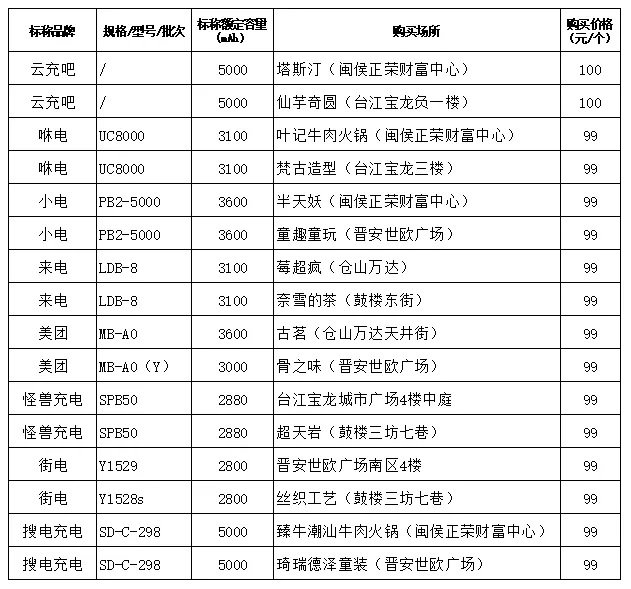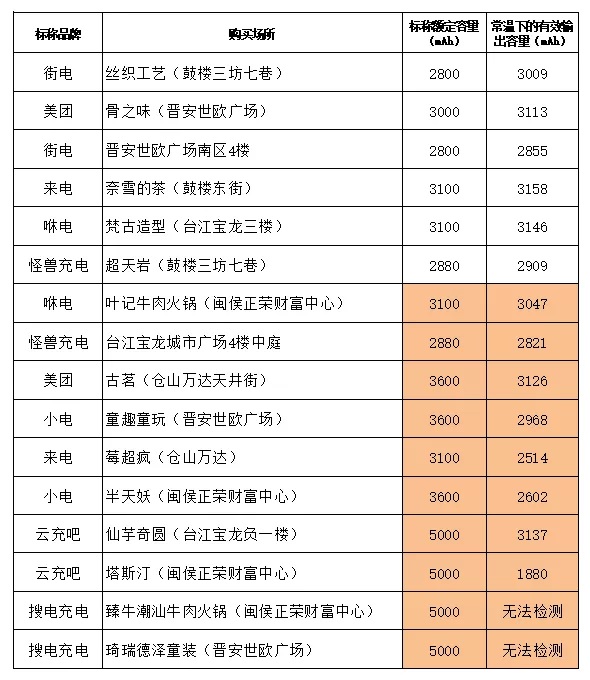I am most afraid that my mobile phone will run out of power when I go out.
I haven’t brought a power bank yet.
Sharing the power bank is the "savior" at this time.
Come and see
Fuzhou City Consumer Protection Committee of Fujian Province recently issued
Comparison and evaluation results of 16 shared power banks
▲
1. All safety protection items have passed the test.
2. All signs and warnings are not standardized.
3. More than half of the output capacity at room temperature is not up to standard.
There are 16 samples in this comparison test, with nominal rated capacities ranging from 2800mAh to 5000mAh, including 8 brands of street electricity, small electricity, incoming calls, monster charging, cloud charging bar, Hudian, Meituan, and Sodian charging.

Note: The shell of the shared power bank is marked with "Battery capacity: 5000mAh" and the words "5000mAh" in large characters, but the rated capacity of the shared power bank is not indicated, so this value is regarded as the rated capacity, the same below.
Can be rented without deposit with credit points
For the 8 shared power bank brands in this comparison test, consumers only need to use mobile devices such as mobile phones to scan the QR code on the device screen through credit points (or pay the deposit) to rent a shared power bank, eliminating the risk of consumers returning the deposit. If the shared power bank is not returned after a certain period of time, it will be regarded as a consumer purchase and relevant fees will be deducted. Among them, the cloud charging bar is 100 yuan each, and other brands are 99 yuan each.
Signs and warnings are 100% non-compliant
According to Article 24 of the "Regulations on the Implementation of the Standardization Law": "Enterprises that implement national standards, industry standards, local standards or enterprise standards in production shall mark the code, number and name of the execution standard on the product or its manual and packaging."
In the case that the shared power bank cannot provide consumers with instructions and packaging, the standard information should be marked on the battery body.
According to GB 31241-2014 "Safety Requirements for Lithium-ion Batteries and Battery Packs for Portable Electronic Products" and GB/T 35590-2017 "General Specifications for Mobile Power Supplies for Portable Digital Devices in Information Technology", the identification and warning instructions for shared power banks are as follows:
Use Chinese to indicate the product name, battery type, model, rated capacity, rated voltage and current, positive and negative polarity (products that can be structurally guaranteed that users cannot cause misinsertion under any use conditions can not be marked with polarity), manufacturer or trademark. And there should be Chinese warning instructions on the body or minimum packaging of the battery pack, such as: do not disassemble, hit, squeeze or put into fire; if there is serious expansion, do not continue to use; do not expose to high temperature environment.
The signs and warnings of this shared power bank comparison test are all non-standard, which should attract the attention of relevant operating enterprises and management departments.
Half of the shared power banks were not marked with Chinese warning instructions such as "Do not disassemble, hit, squeeze or put into fire", "Do not continue to use if there is serious expansion" and "Do not place in a high temperature environment" to remind consumers of safe use precautions;
Except for the product standard "GB/T 35590-2017" marked on the call and the "battery type: lithium polymer battery" marked on the monster charging, the rest are not marked with product standards or battery types;
Cloud charging bar, search power charging logo is too simple, search power charging is not even marked with rated capacity.
More than 50% of the output capacity at room temperature is not up to standard
Shared power bank increases with the number of charges
Output capacity decay may occur
If the operating company is not replaced in time
Products with an effective output capacity lower than the rated capacity
It will mislead consumers
Cause consumers to pay normally
But it cannot achieve the corresponding charging effect.
There are even potential safety hazards
This comparison test takes the effective output capacity at room temperature as an important comparison indicator for shared power banks, and tests the effective capacity of the final conversion output after multiple losses when the shared power bank works. In simple terms, it is the capacity that consumers can actually use when charging.
According to GB/T 35590-2017 "General Specification for Mobile Power Supply for Information Technology Portable Digital Devices", the effective output capacity at room temperature should not be lower than the rated capacity, and the appearance of the mobile power supply should be free of obvious deformation, and it should not explode, vent, catch fire, leak, or break.
Among the 16 shared power banks in this comparison test, the two samples of the Sodian power bank could not be tested due to the need to use a dedicated charging box, and the other samples did not have obvious deformation in appearance after the test, nor did they explode, deflate, catch fire, leak, rupture, etc.
However, the effective output capacity of 8 of the 14 samples tested was lower than the nominal rated capacity, and the deviation was more than -10% in 6 models. Among them, a shared power bank from Yunchong Bar was even lower than the rated capacity by 62.4%.

All safety protection items passed the test
In this comparison test, three safety protection functions of overcharge protection, overdischarge protection and short circuit protection of the samples were tested. The results showed that among the 16 samples, except for the two samples of power search and charging that could not be tested due to design problems, the remaining 14 samples could be activated for protection, and there was no explosion, deflation, fire or liquid leakage.
In addition, this comparative test also tested the external short circuit items of the cells (lithium batteries) in the shared power bank at room temperature, and the results showed that 16 samples of the shared power bank met the standard requirements.
Consumer Tips
Buy a shared power bank to do
"One choice, two looks, three distinctions, four uses"
1. Select the brand after-sales service.
Try to choose a shared power bank brand with a large market size, many cooperative merchants, and guaranteed after-sales services to avoid situations such as rental products that cannot be charged, easy borrowing, continuous deduction after return, and poor customer service communication.
2. Check the appearance of the product
When taking out the shared power bank, first check whether the surface of the product is clean, whether it is deformed and cracked, whether the logo is clear, whether the interface touchpoint is rusted, whether the interface line is damaged, and whether it can charge the device normally.
Step 3 Identify key information
Consumers should first look at the rated capacity when choosing a shared power bank, and do not be misled by the battery capacity marked by individual companies in large characters. The larger the rated capacity, the longer it takes to charge the relevant equipment, and the more times it is charged.
4. Proper and safe use
When using a shared power bank, it should be handled with care to avoid falling, impact, and contact with heavy objects or sharp metal parts, causing the internal battery bulge to break. At the same time, the input and output ports should not be in contact with metal parts such as keys to prevent internal short circuits.
Source/China Consumer News · China Consumer Network
Reporter/Zhang Article